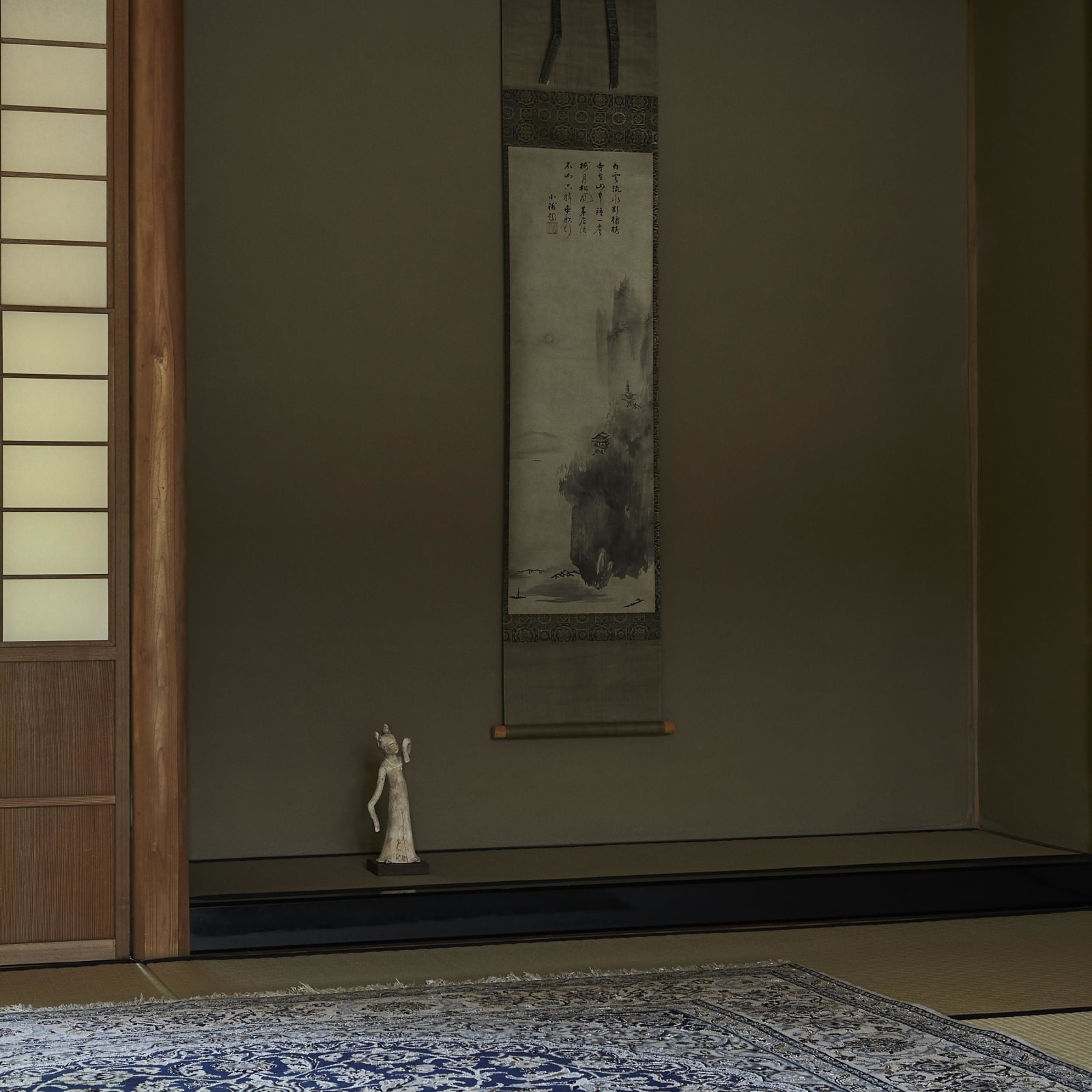Painting by Yōgetsu (act. late 15th century); Inscription by Ōsen Keisan (1428−1493)
Landscape in Ink
Ink on paper, hanging scroll
Inscribed with a seven-character quatrain
With authentication by Okura Kyusui, double boxed
Seals: Kanbai (Osen); Yogetsu (Yogetsu)
96 x 31.8 cm
168 x 34 cm (overall)
Inscribed with a seven-character quatrain
With authentication by Okura Kyusui, double boxed
Seals: Kanbai (Osen); Yogetsu (Yogetsu)
96 x 31.8 cm
168 x 34 cm (overall)
Further images
Provenance
Collection of Ozu FamilyLiterature
Komatsu, Shigemi. Nihon shoryu zenshi. Tokyo: Kodansha, 1970.Komatsu, Shigemi. Nihon shoseki taikan. vol. 8. Tokyo: Kodansha, 1980.
The inscription is written by Osen Keisan, a Zen Buddhist monk, as well one of the leading figures of Higashiyama culture. Listed chronologically in his own writing, Hoan kyoka gaishu, this poem was composed in 1491. The painting itself was presumed to be executed a little prior to the inscription. The seal “Yogetsu” on the present work is similar to the one on Priest Xianzi Holding a Shrimp in the Sanso Collection; yet, the former seal is closer in style to the one which is copied in Koga biko (handbook of classical painting) than the latter one is. Of the surviving works by Yogetsu, such so (informal) style landscape painting was not found, yet the reduced-size drawings of such kind were documented in the aforementioned book. Many depictions, such as the distinctive rocks in the foreground, have in common with the present work. Though the overall composition is close to Sesshu’s Haboku Landscape (National Treasure) in the Tokyo National Museum, the movement of Yogetsu’s brush was running vertically rather than rushing zigzag like the one in Sesshu’s. Another example is Yogetsu’s representative work, a pair of folding screens in Shubun’s shin (regular) style titled Landscape of Four Seasons (Important Cultural Property), in which the texture of rock depicted vertically shares the common expression of brushwork. According to Honcho gashi (painting history of the nation), Yogetsu was “apprenticed under Shubun and Sesshu,” as well as “learned ink painting from Muqi’s work.” The soft brushed tone of trees in this work is reminiscent of Eight Views of Hsiao-hsiang District by Muqi. The following, “the simplified brushwork creates a gentle, misty atmosphere,” is as if an annotation to the present work.
Yogetsu (monk painter; act. late 15th century)
Also known as Wagyoku.
Satsuma-born late Muromachi period monk painter. Commoly known as “Kasagi Yogetsu” for his dwelling in Kasagi-dera Temple. Disciple of Shubun and Sesshu, and studied ink wash painting from Muqi’s works. Excelled in landscape, figure, and birds and flowers paintings.
Osen Keisan (Zen priest; 1429−1493)
Also Known as Shoho; Hoan; Kinka; etc.
Harima-born late Muromachi period Rinzai School Zen priest. Osen is his buddhist name. The 239th chief abbot of Nanzen-ji Temple and the 79th chief abbot of Shokoku-ji Temple. Studied under Eiso of Jotoku-in, Shokoku-ji Temple, and inherited the teachings of Ryuen Honju of Ankoku-ji Temple and Donchu Doho. At the time of the Onin War, evacuated to Jiun-ji Temple in Omi and Ryumon-an of Eigen-ji Temple with Togen Zuisen, where he became close to the poet Ogura Sanezumi in Shikiro-an. After the post of the chief priest of Toji-ji Temple, was promoted to Shokoku-ji and Nanzen-ji Temples. Served as Sorokushi of Rokuon-in and was active as the adviser for diplomacy and literature to the Muromachi Shogunate.
Yogetsu (monk painter; act. late 15th century)
Also known as Wagyoku.
Satsuma-born late Muromachi period monk painter. Commoly known as “Kasagi Yogetsu” for his dwelling in Kasagi-dera Temple. Disciple of Shubun and Sesshu, and studied ink wash painting from Muqi’s works. Excelled in landscape, figure, and birds and flowers paintings.
Osen Keisan (Zen priest; 1429−1493)
Also Known as Shoho; Hoan; Kinka; etc.
Harima-born late Muromachi period Rinzai School Zen priest. Osen is his buddhist name. The 239th chief abbot of Nanzen-ji Temple and the 79th chief abbot of Shokoku-ji Temple. Studied under Eiso of Jotoku-in, Shokoku-ji Temple, and inherited the teachings of Ryuen Honju of Ankoku-ji Temple and Donchu Doho. At the time of the Onin War, evacuated to Jiun-ji Temple in Omi and Ryumon-an of Eigen-ji Temple with Togen Zuisen, where he became close to the poet Ogura Sanezumi in Shikiro-an. After the post of the chief priest of Toji-ji Temple, was promoted to Shokoku-ji and Nanzen-ji Temples. Served as Sorokushi of Rokuon-in and was active as the adviser for diplomacy and literature to the Muromachi Shogunate.









